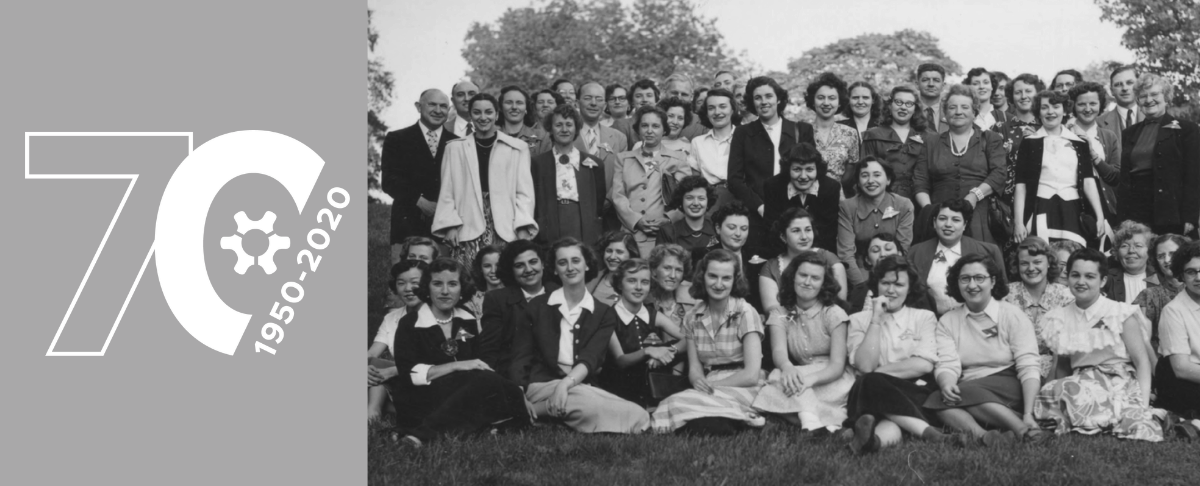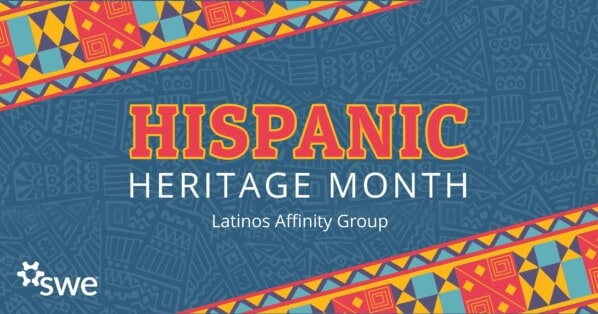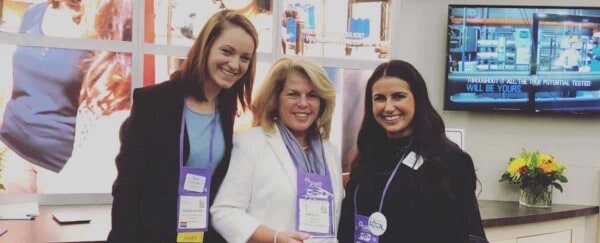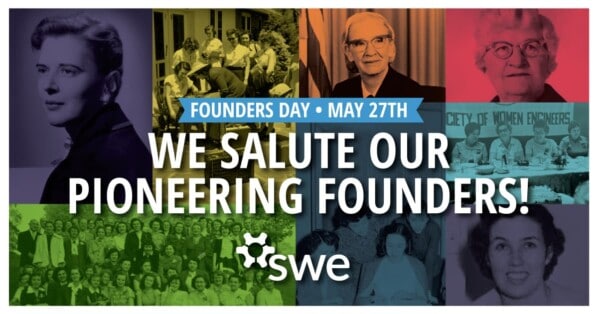Listen to the our podcast or read the transcript below, then make sure to share it with your colleagues and friends! Be sure to check out our other archives podcasts, as well.
Anne Perusek: Welcome to SWE Stories: Tales From the Archives. I’m Anne Perusek, SWE’s director of editorial and publications.
Troy Eller English: And I’m Troy Eller English, SWE’s archivist.
Perusek: This year marks the 70th anniversary of SWE. Unfortunately, we are not able to gather in person for this celebration because of the COVID-19 pandemic. Instead we hope to both honor the women who founded SWE all those years ago and to lift your spirits with some of the lighter tales from SWE’s founding meeting and early years.
Eller English: The seeds for SWE’s founding in 1950 were planted several years earlier, when female engineering students at Philadelphia’s Drexel Institute, as it was called then, formed a student group called the Society of Women Engineers. In the fall of 1945 there were reportedly eleven women enrolled as freshman engineering students, five upperclassmen, and another eight women enrolled in Drexel’s engineering evening school. At the 2015 SWE Region C conference, Fellow and founding member Alma Kuppinger Forman humorously recalled the first gathering of Drexel’s woman engineering students at a formal tea hosted by the Dean of Women, Dorothy Young, where the upperclassmen shared some key information and lessons learned with their newer peers.
Alma Kuppinger Forman [Audio recording]: I remember one particular event that changed my life, and indirectly affected all of you. That was a tea that the women engineers attended at Drexel University given by the Dean of Women. Now, in order to do that, we had to put on our hats and put on our white gloves because that was considered the norm at the time. You just didn’t go to tea without these amenities, right? Now, when we got there, there was a room full of – well, not that many, but there was a room full of people that I didn’t know. They were fellow engineering students. So we got to know each other.
And then you know what we did? We got together to hang out and have lunch. And we met in the court and, you know, just chit-chatted. But we wanted to let the incoming female engineering students [know] about an event that they should be involved in and know about. There were no women’s restrooms in Curtis Hall where we had all our classes! [audience laughter] The nearest one was on the second floor in the far corner of the main building. That wasn’t all. There was a required course for the machine shop. Everybody had to take this course, except the chems [chemical engineering students], lucky people. So then you had to go through the men’s locker room to approach the door to the machine shop. [audience laughter]. So you had to do this: you had to sing loud and clear as you stepped over into the men’s locker room, [singing] “She’s comin’ around the mountain when she comes, she’s comin’ round the mountain when she comes!” [audience laughter] It alleviated, probably, embarrassing situations. Then, in November of 1946, the girls petitioned the student council to have an organization, an official organization on campus, called the Society of Women Engineers.
Perusek: Meanwhile, working women engineers were starting to network locally in Philadelphia, Boston, Washington D.C., and there was a particularly well-organized group of working engineers and students in New York City that started calling itself the Society of Women Engineers around 1948, completely unaware of the other SWE at Drexel. That is, until 1949 when the students of Drexel’s SWE group hosted a conference, chaired by Alma Kuppinger Forman, for women engineering students from other East Coast schools. They called it the “First Conference of the Society of Women Engineers,” although we no longer consider it as such, since it predates the founding of the Society as we know it and it was limited to students.
Eller English: And incidentally, there was another Society of Women Engineers group at the University of Colorado in 1946, and they had no inkling of the groups that were forming on the East Coast, and vice versa.
Perusek: Doris McNulty, another engineering student at Drexel during this time, and a founding member of SWE, recalled that 1949 student conference when the student group at Drexel and the students from the New York group first met. McNulty spoke about SWE’s founding and early years in a speech at SWE’s tenth-anniversary celebration during the 1960 Eastern Seaboard Conference, a predecessor to today’s We Local conferences. While we don’t have a recording, we do have her hand-written speech in the archives. In it, she recalled several highlights, listing them as:
“The important outcome of this conclave was the formation of a regional student organization known as the “Society of Women Engineers,” with an adjunct graduate group.
Fond recollections of this memorable event include the laughter letters from “Clare” and “Marion” brought. They were male students.
Dr. Lillian Gilbreth’s encouraging remarks to be ever mindful of our ideals and not to be afraid of hard work.
The awards of autographed copies of Frank Gilbreth’s popular book “Cheaper by the Dozen.”
The embarrassment at the “Sansom House” when as hostess for a tour of Philadelphia, I learned that I had insufficient funds for the group. The conference treasurer, Jane Becker Fisher, came to my rescue after a frantic telephone call for help.
The student group’s work that first year was carried out under the leadership of Phyllis Evans Miller, then a mechanical engineering student.
The graduate group was carried on by Beatrice Hicks, Roslyn Keller, Betty Jay, Dr. Grace Hopper, Miriam Gerla and a host of others.”
Eller English: In 1950, on May 27 and 28, more than sixty women engineers and engineering students gathered in Ringwood, New Jersey at The Cooper Union’s Green Engineering Camp, which has affectionately become known by SWE members as Camp Green. The purpose of this meeting was to form a unified, national organization of students, engineering graduates, and working engineers. Many of the attendees were put promptly to work at Camp Green in order to make the meeting a success, and a national organization to support women engineers a reality. Carol Bauer humorously wrote about her volunteer experience in the 1950 Summer Special issue of The Woman Engineer, the newsletter of what became the Metropolitan New York Section. The article was titled, “Excerpts From the Diary of Mrs. Female Engineer, or Why Career Women Like to Eat in Restaurants.” She wrote:
“Saturday 7:00 A.M. After resisting the temptation to toss the alarm clock from my second story window, I struggled into consciousness with the feeling that there was something special about the day ahead. After a heroic effort to bring my brain into focus the light dawned. Most wondrous of all weekends! No dishes to wash, no dinners to prepare! Let the dust accumulate! I was off for a weekend at Camp Green. Nothing to do but exchange notes with other Slipstick Sallys, listen to speeches, and absorb vitamin D.
9:00 A.M. Enjoyed a beautiful drive through green-carpeted countryside. As I was later informed by my less urban associates, this is commonly known as grass. They also called my attention to some marvelous products of nature engineering known as trees.
11:00 A.M. Arrived at Camp Green and after collecting sundry linens and printed matter, I headed for the dormitory. The sun was radiating energy, the birds were vocalizing, and life was very sweet. Then I entered the dormitory and saw the bulletin board. When I revived the birds were off tune and life was a sour lemon. But demonstrating the courage and perseverance of a SWE member in good standing, I heroically reported to the kitchen. If my duty to womankind could be fulfilled by dumping roast beef in laps and gravy in hair, I was prepared to set aside my slide rule and serve my fellow woman.”
Perusek: At the founding meeting at Camp Green, attendees elected Beatrice Hicks as the Society’s first president. Phyllis Evans Miller, former president of the Drexel student group, was elected corresponding secretary. During the business meetings they began the serious work of establishing the mission and framework for the Society as we know it today. But they also made time for fun and building camaraderie amongst their new “SWEsters.” The founding members took a time-out for baseball and badminton games. They had a late evening get-together with games, songs, and snacks. And in her speech at the 1960 Eastern Seaboard Conference, Doris McNulty suggested that SWE’s founders also engaged in a bit of hazing at Camp Green, as well. She remembered:
“All those present were firmly initiated with a rigorous fire drill. Bear in mind that the sleeping quarters were on the second floor of a large converted barn. In the wee small hours of the morning, a blaring bugle aroused us from our slumber and chaperones commanded us to slide down the escape rope in our P.J.s to the dew-soaked grass twenty feet below.”
Eller English: At Camp Green, SWE’s founders set membership dues at five dollars for graduate or professional members, and three dollars for students. They also established the Society’s first four districts, which we now call sections. They were Philadelphia; Metropolitan New York, now it’s just New York; New England, which was later renamed Boston; and Washington, which is now Baltimore/Washington. So those sections are also celebrating their 70th anniversary’s this year.
And they also established several new committees:
- an incorporation committee to investigate how and where to incorporate the Society
- a constitution committee, which quickly became the bylaws committee
- an annual award committee, to establish and select recipients for what is now SWE’s Achievement Award,
- and admissions, convention, auditing, financial advisory, membership, and publicity committees
Perusek: The founding members also established a publications committee and appointed Alma Kuppinger Forman to be the publications director, tasked with regularly sharing news of the Society with its members. In this, too, they found humor. Following the founding meeting at Camp Green, the Metropolitan New York District printed an obituary for its newsletter, called The Woman Engineer, as well as a subsequent birth notice, in the Summer Special 1950 issue. It read:
“WITH DEEP REGRETS…
The editorial family of The Woman Engineer mourns the loss of its dear departed parent newsletter, as of the summer of 1950. To our many loyal followers we extend thanks and fond farewells. But do not grieve too long because
ANNOUNCING A NEW ARRIVAL
Name: Suggestions welcomed for the title of the new regional journal
Arrival: Fall of 1950
Weight: Heavy, we hope
Sex: Female, of course
Chief nursemaids for the new arrival will be appointed by the President of the regional society, Beatrice A. Hicks, with the approval of the council.
Assistants to the chief governess will be the present editors of the district newsletters; Sophia Voskerchian, in charge of New York doings; and Tina Mellili, rounding up world-shattering events emanating from Philadelphia. Elsie Eaves has accepted the headaches involved in the position of Advisory Editor.”
The arrival of the publication was a little overdue, with the first issue of the Journal of the Society of Women Engineers being released in the spring of 1951.
Eller English: We hope you enjoyed hearing about the origins of SWE’s founding, as documented in SWE’s archives. I think we could all use some light-hearted humor at this time. So, stay well, wash your hands, and from myself, Anne, and everyone else at SWE, thanks for listening…and happy 70th anniversary, everyone!
Related Content:
- SWE Stories: Tale From the Archives–Early Achievement Award Recipients Offer Advice
- SWE Stories: Tales from the Archives- Early Achievement Award Recipients Offer Advice Pt.2
- SWE Stories: Tales from the Archives- Early Achievement Award Recipients Offer Advice Pt. 3






